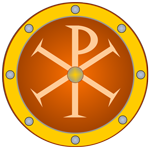
Battle of Dranginai(Battle of Troina) |
year: 1040 |
| A Byzantine victory against the Arabs of Sicily | ★ ★ ★ ★ ★ |
|
enemy: Arabs (of Sicily and Tunis)
|
location: Northeast of Troina in Sicily at the western slopes of mount Aetna
|
accuracy:
●●●●●
|
|
battle type: Pitched Battle |
war: Later Byzantine-Muslim Wars |
modern country:
Italy |
| ▼ The Byzantines(emperor: Michael IV the Paphlagonian) | ▼ The Enemies | |
| Commander: | General George Maniakes | Wale Abdullah |
| Forces: | perhaps 60,000 | |
| Losses: | > 50,000 |
| Background story: |
| Georgios Maniakes had landed in Sicily with a strong army in 1038. In the same year had conquered Messina and defeated a large Arab army at Rometta. After that battle, he quickly conquered another 13 cities in Sicily. Gradually, within two years, the Byzantines had taken control of eastern Sicily. The next target was Syracuse, where the siege, however, was dragging for too long. The Arabs, who were still resisting in the rest of the island, received again significant reinforcements from North Africa. A large army led by Abdullah, son of the Emir of Queran (in present-day Tunisia) moved southeast to the rear of the Byzantine army. Maniakes reacted quickly and, taking the army from Syracuse, moved against them. The moral in the Byzantine army was not good at all due to the differences between Georgios Maniakes and Stefanos Kalafatis, co-leader of the campaign and brother of the Byzantine emperor Michael IV. |
The Battle: |
 The battle of Troina in Skylitzes manuscript Maniakes extended his army to 3 wings that attacked one after the other. During the battle, a strong storm lifted a cloud of dust that blinded and completely disorganized the Arabs. The Byzantines, in order to avoid the caltrops that the Arabs had scattered on the battlefield, wore metal cases on their horses’ feet, like shoes. This trick proved to be very effective, as the Saracens were not prepared to defend themselves against a cavalry attack and, moreover, in a thick cloud of dust. Soon the battle turned into a massacre. According to Skylitzes, the losses of the Arabs were again (as in Rometta) over 50,000! However, the leader of the Saracens, Abdullah, fled from the battlefield and, reaching the shore, boarded a fast ship and managed to escape from Stefanos’ fleet. When Maniakes learned that Abdullah had escaped, he became furious. He blamed Stefanos, whom he insulted and publicly criticized, calling him a coward, lazy and a traitor. In addition, he repeatedly hit him on the head with his whip. A similar incident occurred with the Lombard leader of the Italians, Arduino: Maniakes had him flogged for an arabian black horse that Arduino wanted to keep as a booty, refusing to give it to the general. These two episodes had devastating consequences. First of all, Aldouinos with the Lombards and the Kontaratoi withdrew from the Greek army. Worst of all, Stephen wrote a letter to his brother John Orphanotrophos, who at the time was the mighty man of Byzantium, slandering Maniakes for conspiring against the emperor in order to usurp the throne. Shortly afterwards, the Byzantines finally captured Syracuse, but while Maniakes was preparing to continue on to Palermo, he was recalled to Constantinople, where he was humiliated and imprisoned. Stefanos took over the command of the army in Sicily together with an eunuch named Vassilios Pediaditis. |
Noteworthy: |
| Maniakes built a church on the battlefield to which he donated an icon hagiographed by the Evangelist Luke himself. The church, after the failure of the campaign, was deserted for many years. Much later, in 1172, Margarita of Navarre, mother of the Norman king of Sicily, built a moanstery there, the Abbazia di Santa Maria di Maniace , which still exists today and functions as a museum. Also the province of Catania around that point is still called “Maniace”. |
Aftermath: |
| The victory in this battle was big, but Maniakes’ bad behavior triggered developments that eventually led to a catastrophe. After the departure and imprisonment of Maniakes, the complete incompetence of his replacements resulted in the loss of all the profits of the previous 2 years. Very quickly, all the cities were recaptured by the Arabs except Messina. Stefanos was killed and Vassilios fled to Puglia. Meanwhile, problems with Lombards and Normans began. |
|
|
